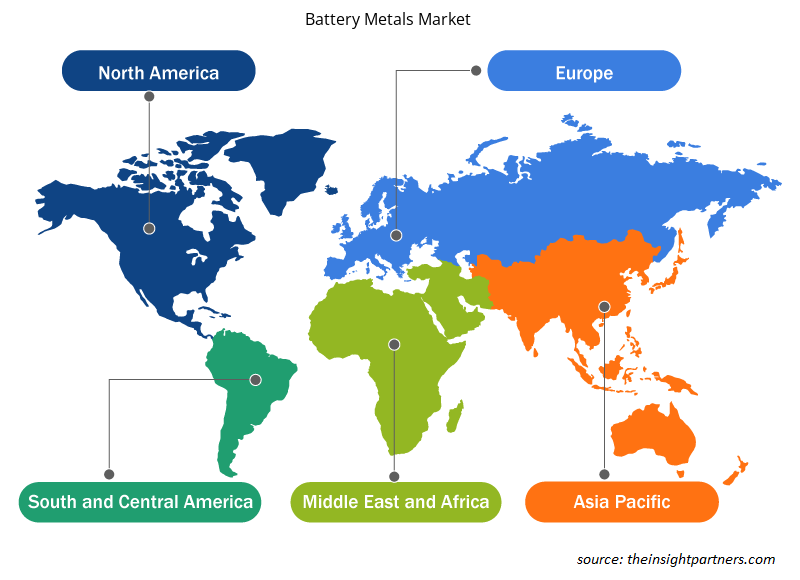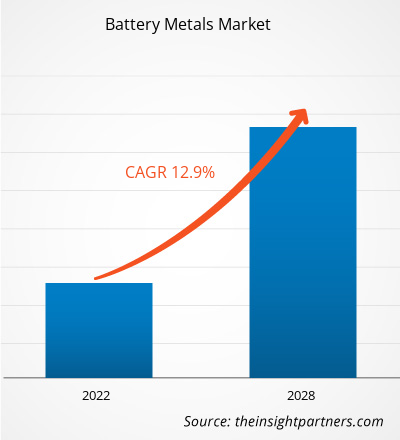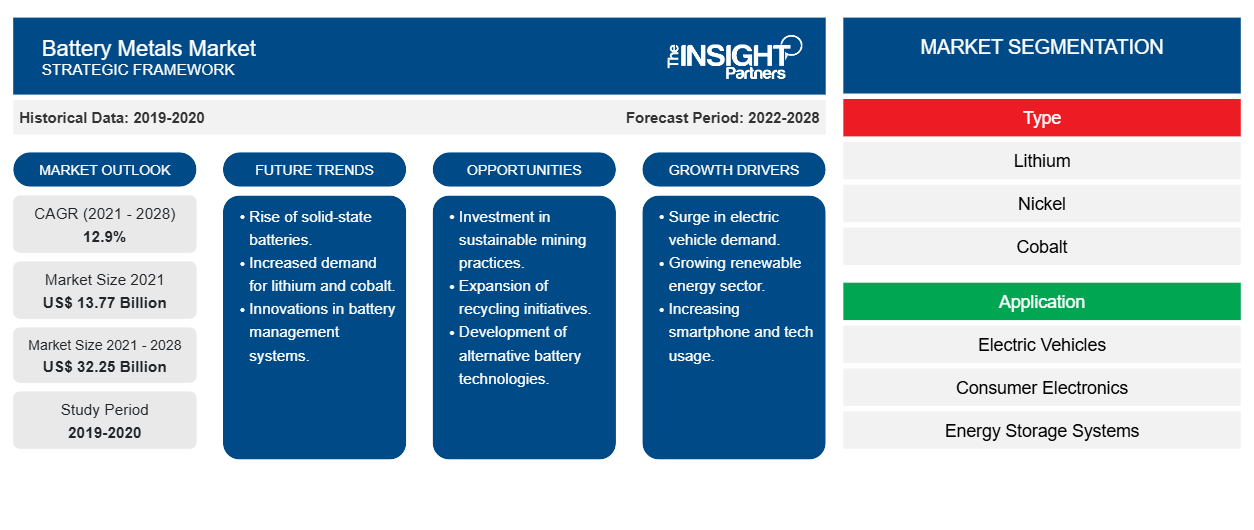[Forschungsbericht] Der Markt für Batteriemetalle soll von 13.770,9 Millionen US-Dollar im Jahr 2021 auf 32.251,1 Millionen US-Dollar im Jahr 2028 anwachsen; von 2021 bis 2028 wird mit einer durchschnittlichen jährlichen Wachstumsrate von 12,9 % gerechnet.CAGR of 12.9% from 2021 to 2028.
Batteriemetalle wie Lithium, Kobalt, Nickel und Mangan werden als Rohstoffe bei der Herstellung von Batterien verwendet. Diese werden auch in Elektrofahrzeugen, Unterhaltungselektronik und anderen Anwendungen eingesetzt.
Im Jahr 2020 hatte der asiatisch-pazifische Raum den größten Umsatzanteil am globalen Markt für Batteriemetalle . Verschiedene Länder im asiatisch-pazifischen Raum erleben einen Aufschwung in der Automobil- und Elektronikindustrie, der das Wachstum des Marktes für Batteriemetalle im Prognosezeitraum wahrscheinlich weiter ankurbeln wird. Darüber hinaus hat der Markt für Elektrofahrzeuge im gesamten asiatisch-pazifischen Raum aufgrund des schnell wachsenden Automobil- und Elektroniksektors ein bemerkenswertes Wachstum verzeichnet.
Passen Sie diesen Bericht Ihren Anforderungen an
Sie erhalten kostenlos individuelle Anpassungen an jedem Bericht, einschließlich Teilen dieses Berichts oder einer Analyse auf Länderebene, eines Excel-Datenpakets sowie tolle Angebote und Rabatte für Start-ups und Universitäten.
-
Holen Sie sich die wichtigsten Markttrends aus diesem Bericht.Dieses KOSTENLOSE Beispiel umfasst eine Datenanalyse von Markttrends bis hin zu Schätzungen und Prognosen.
Die COVID-19-Pandemie führte zu Störungen in der globalen Lieferkette. Viele Branchen, wie Bergbau sowie Chemie und Materialien, standen vor beispiellosen Herausforderungen bei der Einhaltung der Produktions- und Lieferpläne und dem Verkauf verschiedener Waren. Da die Volkswirtschaften jedoch planen, ihre Aktivitäten wieder anzukurbeln, wird erwartet, dass die Nachfrage nach Batteriemetallen weltweit steigen wird. Die Wiederaufnahme des Betriebs in der Automobil-, Elektronik- und anderen Branchen hat den Bedarf an Batteriemetallen weltweit erhöht. Die Unterhaltungselektronikbranche wächst dynamisch mit dem Anstieg der Verbraucherausgaben. Die steigende Nachfrage nach Batteriemetallen in verschiedenen Anwendungen, wie Elektrofahrzeugen, Unterhaltungselektronik und Energiespeichersystemen, sowie erhebliche Investitionen namhafter Hersteller werden voraussichtlich das Wachstum des Marktes für Batteriemetalle in den kommenden Jahren vorantreiben.
Markteinblicke
Wachsende Elektrofahrzeugindustrie
Der weltweite Anstieg der Nachfrage nach Elektrofahrzeugen unterstützt das Wachstum des Marktes für Batteriemetalle. Die auf Batteriemetallen basierenden Produkte werden von der Elektrofahrzeugindustrie in großem Umfang als Ersatz für fossile Energie verwendet, die zum Betrieb der Fahrzeuge benötigt wird. In dicht besiedelten Gebieten werden Elektrofahrzeuge häufig eingesetzt, um die Fahrzeugverschmutzung zu reduzieren, da dort mehr Fahrzeuge eingesetzt werden. Es ist auch ein wichtiger Faktor für die Diversifizierung der Energieversorgung und die Reduzierung der Treibhausgasemissionen. Zu den Vorteilen von Elektrofahrzeugen gehören keine Abgasemissionen, das Potenzial zur Reduzierung der Treibhausgasemissionen und eine bessere Effizienz als Fahrzeuge mit Verbrennungsmotor.vehicels are widley used to reduce the vehicles pollution as number of vehicles used are more in such areas. It is also important factor for providing energy diversification and reducing greenhouse gas emission. Benefits of electric vehicles include zero tailpipe emissions, the potential for greenhouse gas emissions reductions, and better efficiency than internal combustion engine vehicles.
Die Regierungen vieler Länder, darunter China, Indien und die USA, haben Vorschriften erlassen, um die Einführung von Elektrofahrzeugen zu fördern. Elektrofahrzeuge und ihr Markt wachsen aufgrund des anhaltenden technologischen Fortschritts bei der Elektrifizierung von Zwei- und Dreirädern, Bussen und Lastwagen erheblich.three-wheelers, buses, and trucks.
Laut einem Bericht der Internationalen Energieagentur „The Global EV Outlook 2020“ wächst der weltweite Bestand an Elektro-Pkw im Jahr 2019 kontinuierlich und erreichte 7,2 Millionen Einheiten, 40 % mehr als im Jahr 2018. Aufgrund all dieser Faktoren wächst die Nachfrage nach Elektrofahrzeugen/Hybriden und Elektrofahrzeugen/Plug-in-Hybridfahrzeugen. Dies wiederum treibt den Markt für Batteriemetalle erheblich an.EV Outlook 2020' report, there is continuous expansion in global stock of electric passenger vehicles in 2019, reaching 7.2 million units, 40% higher than in 2018. Due to all these factors, the demand for electric vehicles/hybrid and electric vehicles/plug-in hybrid vehicles is growing. This, in turn, is driving the battery metals market substantially.
Typbasierte Erkenntnisse
Der Markt für Batteriemetalle ist nach Typ in Lithium, Nickel, Kobalt und andere unterteilt. Das Lithiumsegment hatte im Jahr 2020 den größten Marktanteil. Das Wachstum des Segments ist auf die zunehmende Verwendung von Lithium in der Elektrofahrzeug- und Elektronikindustrie aufgrund seines geringen Gewichts zurückzuführen.subsegmented into lithium, nickel, cobalt, and others. The lithium segment held the largest market share in 2020. The segment's growth can be attributed to the rising application of lithium in the electric vehicles and electronics industry due to its lightweight property.
Anwendungsbasierte Erkenntnisse
Basierend auf der Anwendung ist der Markt für Batteriemetalle weiter segmentiert in Elektrofahrzeuge, Unterhaltungselektronik, Energiespeichersysteme und andere. Der Markt für Batteriemetalle wird vom Segment der Elektrofahrzeuge dominiert, das im Prognosezeitraum die höchste durchschnittliche jährliche Wachstumsrate verzeichnet. Die steigende Nachfrage nach umweltfreundlichen Fahrzeugen aufgrund geänderter Regulierungsnormen durch verschiedene Regierungsbehörden in Industrie- und Entwicklungsländern hat enorme Auswirkungen auf den Markt für Batteriemetalle.
Albemarle Corporation; Umicore; LG Chem; Ganfeng Lithium Co., Ltd.; BASF SE; Bolt Metals Corp.; Honjo Metal Co., Ltd.; Lithium Australia NL; Vale; und Metso Outotec gehören zu den wichtigsten Akteuren auf dem Markt für Batteriemetalle. Diese Marktteilnehmer konzentrieren sich auf die Entwicklung qualitativ hochwertiger und innovativer Produkte, um die Anforderungen der Kunden zu erfüllen. Albemarle Corporation kündigte die Eröffnung des Battery Materials Innovation Center (BMIC) an seinem Standort in Kings Mountain, North Carolina, an. Das Labor produzierte Lithiummetall-Anodentechnologien, welche die Energiedichte von Batterien steigern, indem durch fortschrittliches Walzen von Lithiummetall Lithiumfolien mit einer Dicke von 20 μm (d. h. etwa einem Fünftel der durchschnittlichen Dicke eines menschlichen Haares) oder weniger hergestellt werden. Jiangsu Ganfeng Power Technology Co., Ltd., eine Tochtergesellschaft von Ganfeng Lithium Industry, zog offiziell in ein neues Werk um und verbesserte seine Produktionskapazität durch den Austausch von Geräten. Jiangsu Ganfeng bietet als Hauptprodukt Lithiumbatteriesysteme für Industriefahrzeuge an, um Kunden mit langlebigen, belastbaren, wartungsfreien und anpassbaren Stromversorgungssystemlösungen zu versorgen und die Umstellung von Industriefahrzeugen von Blei-Säure-Batterien auf Eisen-Lithium-Batterien zu erleichtern.
Bericht-Spotlights
- Fortschrittliche Branchentrends auf dem globalen Markt für Batteriemetalle helfen den Akteuren bei der Entwicklung wirksamer langfristiger Strategien
- In Industrie- und Entwicklungsländern angewandte Strategien für Unternehmenswachstum
- Quantitative Analyse des globalen Marktes für Batteriemetalle von 2019 bis 2028
- Abschätzung der Nachfrage nach Batteriemetallen in verschiedenen Branchen
- Aktuelle Entwicklungen zum Verständnis der Wettbewerbssituation auf dem Markt und der Nachfrage nach Elektrofahrzeugen
- Markttrends und -aussichten in Verbindung mit Faktoren, die das Wachstum des Marktes für Batteriemetalle vorantreiben und bremsen
- Entscheidungsprozess durch das Verständnis von Strategien, die das kommerzielle Interesse im Hinblick auf das Wachstum des globalen Marktes für Batteriemetalle untermauern
- Marktgröße für Batteriemetalle an verschiedenen Marktknoten
- Detaillierte Übersicht und Segmentierung des globalen Marktes für Batteriemetalle und seiner Dynamik in der Branche
- Marktgröße für Batteriemetalle in verschiedenen Regionen mit vielversprechenden Wachstumschancen
Regionale Einblicke in den Markt für Batteriemetalle
Die regionalen Trends und Faktoren, die den Markt für Batteriemetalle im Prognosezeitraum beeinflussen, wurden von den Analysten von Insight Partners ausführlich erläutert. In diesem Abschnitt werden auch die Marktsegmente und die Geografie von Batteriemetallen in Nordamerika, Europa, im asiatisch-pazifischen Raum, im Nahen Osten und Afrika sowie in Süd- und Mittelamerika erörtert.

- Erhalten Sie regionale Daten zum Batteriemetallmarkt
Umfang des Marktberichts zu Batteriemetallen
| Berichtsattribut | Details |
|---|---|
| Marktgröße im Jahr 2021 | 13,77 Milliarden US-Dollar |
| Marktgröße bis 2028 | 32,25 Milliarden US-Dollar |
| Globale CAGR (2021 - 2028) | 12,9 % |
| Historische Daten | 2019-2020 |
| Prognosezeitraum | 2022–2028 |
| Abgedeckte Segmente |
Nach Typ
|
| Abgedeckte Regionen und Länder |
Nordamerika
|
| Marktführer und wichtige Unternehmensprofile |
|
Marktteilnehmerdichte: Der Einfluss auf die Geschäftsdynamik
Der Markt für Batteriemetalle wächst rasant, angetrieben durch die steigende Nachfrage der Endverbraucher aufgrund von Faktoren wie sich entwickelnden Verbraucherpräferenzen, technologischen Fortschritten und einem größeren Bewusstsein für die Vorteile des Produkts. Mit steigender Nachfrage erweitern Unternehmen ihr Angebot, entwickeln Innovationen, um die Bedürfnisse der Verbraucher zu erfüllen, und nutzen neue Trends, was das Marktwachstum weiter ankurbelt.
Die Marktteilnehmerdichte bezieht sich auf die Verteilung der Firmen oder Unternehmen, die in einem bestimmten Markt oder einer bestimmten Branche tätig sind. Sie gibt an, wie viele Wettbewerber (Marktteilnehmer) in einem bestimmten Marktraum im Verhältnis zu seiner Größe oder seinem gesamten Marktwert präsent sind.
Die wichtigsten auf dem Markt für Batteriemetalle tätigen Unternehmen sind:
- Albemarle Corporation
- Bolzenmetalle
- Ganfeng Lithium Co., Ltd.
- Umicore
- LG Chem
Haftungsausschluss : Die oben aufgeführten Unternehmen sind nicht in einer bestimmten Reihenfolge aufgeführt.

- Überblick über die wichtigsten Akteure auf dem Markt für Batteriemetalle
Batteriemetallmarkt nach Typ
- Lithium
- Nickel
- Kobalt
- Sonstiges
Batteriemetallmarkt, nach Anwendung
- Elektrofahrzeuge
- Unterhaltungselektronik
- Energiespeichersysteme
- Sonstiges
Firmenprofile
- Albemarle Corporation
- Umicore
- LG Chem
- Ganfeng Lithium Co., Ltd.
- BASF SE
- Bolt Metals Corp.
- Honjo Metal Co., Ltd.
- Lithium Australien NL
- Tal
- Metso Outotec
- Amerikanische Elemente
- Historische Analyse (2 Jahre), Basisjahr, Prognose (7 Jahre) mit CAGR
- PEST- und SWOT-Analyse
- Marktgröße Wert/Volumen – Global, Regional, Land
- Branchen- und Wettbewerbslandschaft
- Excel-Datensatz
Aktuelle Berichte
Verwandte Berichte
Erfahrungsberichte
Grund zum Kauf
- Fundierte Entscheidungsfindung
- Marktdynamik verstehen
- Wettbewerbsanalyse
- Kundeneinblicke
- Marktprognosen
- Risikominimierung
- Strategische Planung
- Investitionsbegründung
- Identifizierung neuer Märkte
- Verbesserung von Marketingstrategien
- Steigerung der Betriebseffizienz
- Anpassung an regulatorische Trends























 Kostenlose Probe anfordern für - Markt für Batteriemetalle
Kostenlose Probe anfordern für - Markt für Batteriemetalle